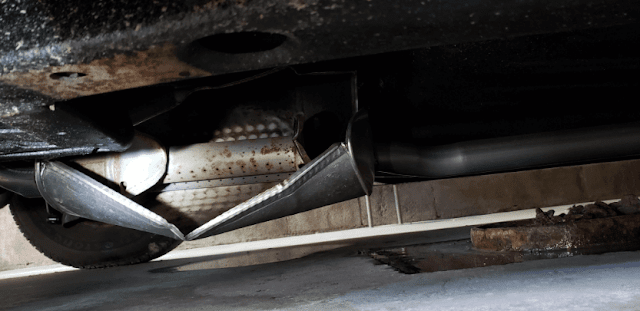Legal Decibel Emissions for a Car Exhaust
A deep sense of satisfaction slips through your vibrating bones when your exhaust system lets rip, but that happy grin rapidly drops away when you enter a residential district. Clearly, your car exhaust is generating too much noise. It’s breaking some local ordinance and upsetting your neighbours. Let’s pacify that street full of howling dogs and angry residents by making sure your exhaust noise level is street legal.
Gain Some Noise Perspective
The decibel scale measures sound intensity. The loudness of the sound is calibrated across a logarithmic scale, but we don’t really need to know the mathematics behind the science. Suffice to say, we have a measurement system for sound intensity, and we also have several reference points that illustrate key points on that chart. If you’re listening to a regular conversation, you’re experiencing 60-dB (decibels) of loudness. A crowded party ramps that figure up to 70-dB. It’s at this point that you really recognize the sound as an irritant. This is a penetrating, braying noise that breaks your concentration. Now, imagine moving from the 90-dB threshold to a 120-dB noise source. Stuck in this scenario, you’re cringing and covering your ears while jet aircraft take off, or maybe you’re locked inside a steel mill, a place where ear defenders are mandatory. Keeping those references in mind, just how loud is too loud when a performance-tuned car exhaust issues its throatiest roar?
Obeying Legal Decibel Limits
Let’s answer that last question before we go any further. An aggressive exhaust system can easily throw out a 110-dB roar. That’s enough noise to trigger even the most intelligent car alarm and send the local pooch into an hour-long howl of protest. We need to do our bit to reduce these animalistic tones, even if they do make you happy. In order to accomplish this feat, the chosen aftermarket exhaust system has to shape and minimize the sound intensity envelope while it also expels the engine backpressure. What exactly are these legal limits? The EPA (Environmental Protection Act) legislates a 90-dB limit, although motorcycles are allowed to reach a 94-dB threshold.
Legal decibel levels vary from one nation to the next. Nonetheless, an aftermarket enthusiast should know this threshold, even it’s different in the next state across. After all, the legislature penalizes the car owner if the laws are indiscriminately broken. Have the exhaust system checked for sound intensity. Use your own sound level tester or a garage inspection test to avoid a violation. Incidentally, a damaged exhaust system can easily produce prohibitively loud quantities of noise, so get that noisy vehicle down to your exhaust shop before it earns you a citation.
Trufit Exhaust
437 Warrigal Road,
Moorabbin, VIC-3189,
Australia
Areas serviced: Melbourne
Tel: 03 9555 5688
Main source URL: Legal Decibel Emissions for a Car Exhaust



Comments
Post a Comment